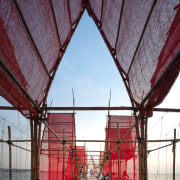Fishing for a sustainable future
An oyster scaffolding pavilion by Chat Architects aims to re-vitalise a struggling fishing/seafood industry through the creation of a new kind of eco-tourism
Designed by Chat Architects
From the architects:
The Angsila Oyster Scaffolding Pavilion by Chat Architects is located off the coast of the historic Angsila fishing village in Chonburi Province, Thailand.
Once a thriving small-scale fishing town, the Angsila community has struggled in past decades to sustain the way of life of its fisheries due to a variety of factors.
On an ecological scale, unfiltered waste from nearby factories and new suburbs is released into the rivers and canals, feeding directly into Angsila Bay.
The resulting diminished water quality and decreased aquatic life and profitability in seafood cultivation has led to the abandonment of traditional fisheries.
In particular, the younger generation has left their hometown to seek more profitable jobs in factories, offices, or retail businesses in nearby Bangkok.
As a result, the Angsila Oyster Scaffolding Pavilion Project aims to re-vitalise Angsila's struggling fishing/seafood industry through the creation of a new oyster eco-tourism infrastructure prototype.
The pavilion design draws on and “bastardises” the widely deployed bamboo scaffolding traditionally used for oyster cultivation.
When in use, local fishermen bring small groups of visitors from Angsila to the pavilion, where they can handpick oysters pulled from the ocean below, which are then prepared fresh to eat … a sea-to-table dining experience in a remarkable coastal setting.
This new oyster-tasting experience allows the Angsila fishermen to relay their fishing history and oyster cultivation heritage directly to visitors in a new and interactive way.
Serving shellfish cultivated right on the scaffolding also ensures seafood freshness for tourists, while providing the Angsila fishermen with an opportunity to campaign for the protection of Angsila Bay’s sensitive coastal ecology.
When not utilised as a tasting pavilion for eco/tourists, the covered platforms become recreational fishing piers for local fishermen, who bring their families to the platform with fishing poles, bait, and hooks in order to catch a variety of local fish naturally drawn to the clean, shellfish-filtered waters surrounding the oyster and mussel bundles in the waters below.
The pavilion design innovates from existing every day, sustainable, inexpensive materials, labour, and construction techniques.
Like traditional oyster scaffoldings, the new scaffolding is built entirely by Angsila fishermen, utilising local shallow-ocean bamboo construction techniques that require no power tools.
The fishermen manually drive each bamboo column into the ocean floor, 'pogo-stick' style.
Rejected car seatbelts, acquired at a discount due to discolouration from local auto plants, are used to tie all of the bamboo members together.
A graphic red (complementing the greenish bay waters), light-filtering agricultural tarp, commonly used in nearby nurseries, shades visitors from the ocean sun, yet allows for the passage of ocean breezes.
Credit list
Project
Architect
Designed by: Chat Architects
Story by: Trendsideas
Home kitchen bathroom commercial design
Diving into nature
Personality plus
Classic looks, contemporary efficiency














